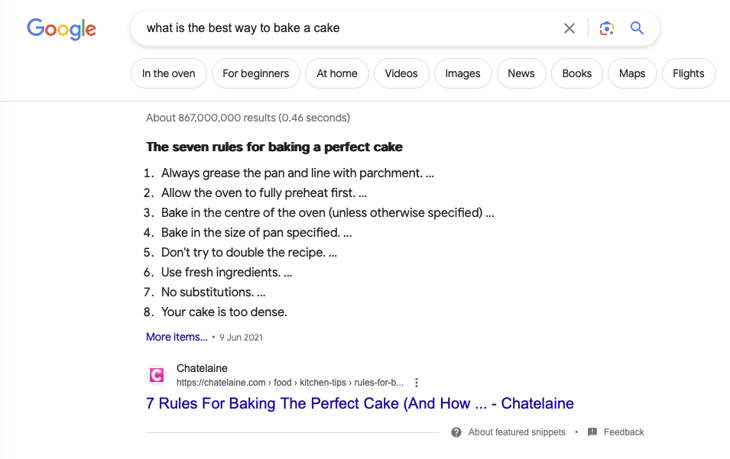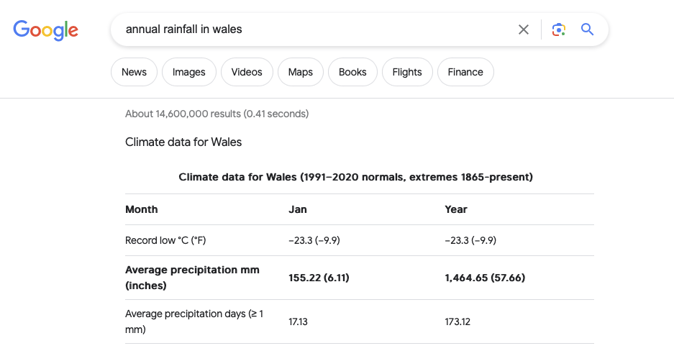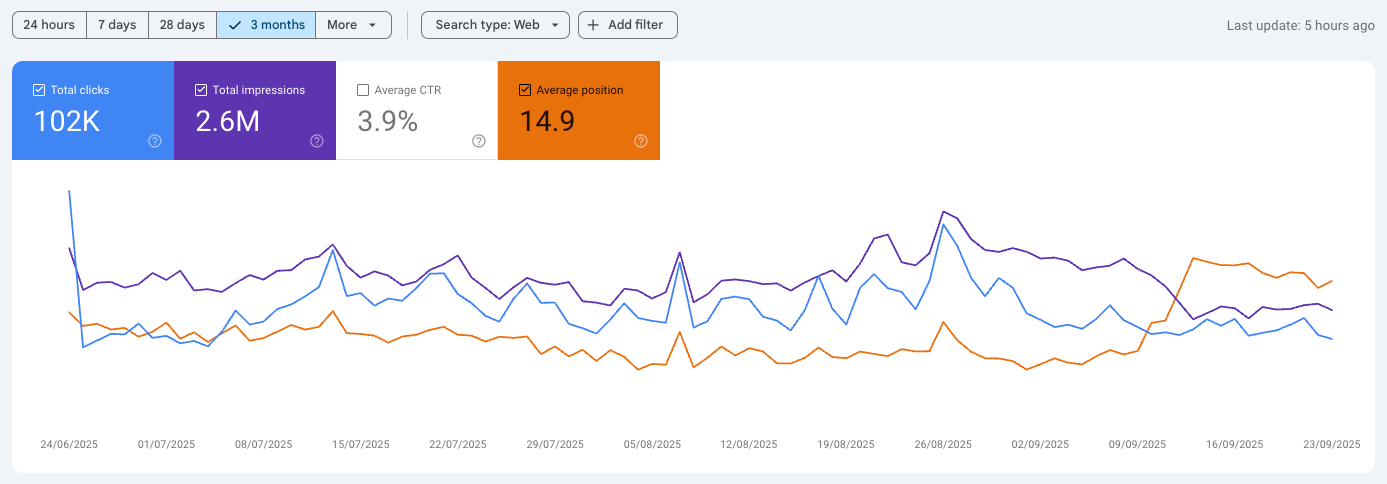In the digital realm, mastering Search Engine Optimisation (SEO) is akin to wielding a magic wand...
How to Optimise Content for Google’s Featured Snippets
With the ever-evolving landscape of search engines, staying ahead of the curve has never been more important. One such forefront in the SEO sphere is the prominence of Google’s featured snippets. These bite-sized information blocks take prime position in search results, serving users’ need for quick, relevant information.
Given the high visibility and credibility of featured snippets, it’s no wonder businesses and bloggers alike are vying for their piece of the spotlight. Let’s delve into the intricacies of Google’s featured snippets and explore some best practices for optimising your content.
Table of Contents
What Exactly are Google’s Featured Snippets?
At the top of many search results, especially those that pose a question, you will find a box displaying a concise answer or a summary. This box is the renowned ‘featured snippet’. Different from regular organic search results, the snippet aims to provide users with a quick and definitive answer to their question, eliminating the need to browse the results and click through to a website.
The Evolution of Featured Snippets
Over the years, the digital realm has undergone transformative shifts, with search engines refining their algorithms to offer the most precise results. Google’s featured snippets have been a key part of this evolution.
Before Google rolled out this feature, users had to sift through multiple links to get answers. This traditional search model wasn’t always user-friendly, especially for those seeking quick answers to straightforward questions. The need for an efficient, direct-response model was clear, leading Google to introduce featured snippets.
Advantages of Snippet Real Estate
Being at the top of Google’s search results offers several perks, including:
- Increased visibility: Snippets are displayed prominently, often capturing the majority of a user’s attention when they search.
- Enhanced credibility: Earning a snippet spot can bolster your brand’s authority. It’s akin to receiving a nod from Google about the reliability and relevance of your content.
- Higher click-through rates: Featured snippets can significantly improve your site’s click-through rates, bringing in more organic traffic.
The Three Types of Featured Snippets
There are three primary types of featured snippets:
- Paragraph type: These offer concise answers in text format. They are ideal for direct questions, such as ‘what is a featured snippet?’

- List type: Ideal for how-to guides, ‘top X’ lists, or recipes. They present content in either a bulleted or numbered list.

- Table type: Perfect for presenting data, these display information in a structured table layout.

Getting Your Content Featured in a Snippet
To optimise your content for Google’s featured snippets, it’s crucial to implement a few tried-and-tested strategies. These are:
Research and Target the Right Queries
Start by pinpointing which questions your audience is asking. Tools like SEMrush or Answer The Public can be invaluable options here. By understanding the queries that people are asking within your niche, you can structure your content to provide direct and concise answers.
To do this effectively, it’s important to understand your audience, not just what they are asking. Craft detailed personas of your typical audience members. What are their pain points, questions, or curiosities? Tailoring your content to these personas can make it more snippet worthy.
Incorporate the ‘What is’ Heading
Begin your content optimisation by inserting a ‘What is [keyword]’ heading. This gives Google a clear cue about the potential relevance of the following content for a featured snippet. Typically, position this heading shortly after your introduction, ensuring that it blends within the content seamlessly.
Prioritise High-Quality Content
Google prioritises content that is authoritative and trustworthy. Focus on producing well-researched, original content that adds genuine value to your readers. While it’s essential to cover a broad spectrum of topics, depth is crucial for snippet optimisation. Don’t just skim the surface when creating content. When discussing a topic, explore its nuances. Detailed guides or comprehensive how-to articles can stand out and are often featured in snippets.
Plus, it can be worth focusing on providing information on lesser-addressed sub-topics in your field. This niche content can often have less competition and can be ideal for featured snippets.
Implement the ‘is’ Sentence Structure
For featured snippet optimisation, utilise the sentence structure ‘[Keyword] is…’. This pattern, evident in many successful featured snippets, acts as a catalyst for Google to spot relevant content. Leading with this structure can help boost your snippet chances.
Optimise for Voice Search
With the growing popularity of smart speakers and voice-activated assistants, many users pose queries in a conversational tone. Ensure your content can cater to this trend by framing your answers in a natural, dialogue-friendly manner.
Summarise the Subject in 2-3 Sentences
Make sure that your content encapsulates the topic concisely within two to three sentences. Aim for clarity here:
- Initiate with a topic definition.
- Follow with 2-3 essential facts.
- Refrain from unnecessary phrasing.
Align with the Snippet’s Format
Mirror the format you observe in the existing featured snippet for your query on the search engine results page (SERP). If the snippet is in paragraph form, for example, integrate a relevant 2-3 sentence text in your content. On the other hand, if it’s a list, make sure your content reflects that.
Exclude Brand Names
Incorporating brand names can lead to your content becoming ineligible for snippets. Given that snippets power voice search, content needs to be universally understandable. Replace brand-specific terms with generic ones to improve your chance of being featured.
Avoid First-Person References
As with brand names, first-person language can also be problematic, especially when considering voice search functionality. Using second-person language is a better choice for clarity and broad relevance.
Focus on High-Ranking Opportunities
Generally, higher-ranked pages have an increased likelihood of obtaining a featured snippet. When strategizing, spotlight keywords where your page is already ranking in the top 5.
Advanced Snippet Optimisation Techniques
While the basics provide a solid foundation, exploring more advanced tactics can further enhance your chances of snagging that snippet spot.
Semantic Search and Snippets
Google’s shift towards semantic search – understanding user intent rather than just keywords – has profound implications for featured snippets. To cater to this, you should:
- Answer the ‘why and ‘how’: Beyond the ‘what’, ensure your content addresses the reasons behind the query and provides comprehensive solutions.
- Link internally: Relevant internal links can help Google understand the depth and breadth of your content, showing that you cover topics thoroughly.
Leveraging Schema Markup
Schema markup, a form of microdata, provides search engines with a clearer understanding of your content’s context. By incorporating this, you can:
- Enhance SERP presentation: Schema can improve how your content is presented in SERPs, making it more attractive for a snippet.
- Clarify content type: Specify whether your content is a product review, how-to guide, recipe, event, or another category, allowing Google to present it accurately.
Capitalise on Snippet Scalability
Observations suggest that Google occasionally extracts heading tag information for featured snippets. Therefore, manipulating HTML, such as shifting paragraph tags to H2 or H3 tags, could heighten your snippet potential.
The Myths and Misconceptions
The world of SEO is no stranger to myths and misconceptions, and featured snippets have certainly attracted their fair share. Some common myths are:
Only Top-Ranking Pages Get Featured
Reality: While it’s true that many featured snippets are sourced from the top-ranking pages, it’s not an exclusive club. Google is primarily concerned with sourcing the most relevant and concise answer to a query. If your content, even from a lower-ranking page, fits the bill, it has a shot.
Snippets Reduce Organic Traffic
Reality: A prevalent concern is that by providing direct answers, snippets might deter users from clicking through. In practice, however, featured snippets often increase brand visibility and authority, leading to improved click-through rates overall.
Only Certain Content Types are Eligible
Reality: While lists, tables, and Q&A formats are popular, they aren’t the only content types that get featured. Any content that effectively addresses a user query, from guides to step-by-step tutorials, has potential snippet value.
The Bigger Picture
While achieving a featured snippet spot can increase your sites visibility and credibility, it’s also essential to look at your SEO strategy in a holistic way. Aiming solely for the snippet spot without considering other crucial SEO aspects can be counterproductive. Instead, always focus on the broader goal of providing value to your users and improving the overall user experience.
The Future of Featured Snippets
As voice search becomes more prevalent, and AI-powered digital assistants play a more significant role in our daily lives, the role of featured snippets is likely to expand even further. For example, popular devices like Google Home and Amazon Alexa often pull information from featured snippets for voice search responses.
As technology evolves, the format of snippets is likely to follow. We might begin to see more interactive snippets, or those integrating multimedia elements in the not-so-distant future.
While securing a spot in Google’s featured snippets is a commendable achievement, it’s essential to view it as a component of a comprehensive SEO and content strategy. Need help with this? Reach out to us at Bristechtonic SEO today, for all your SEO needs.




